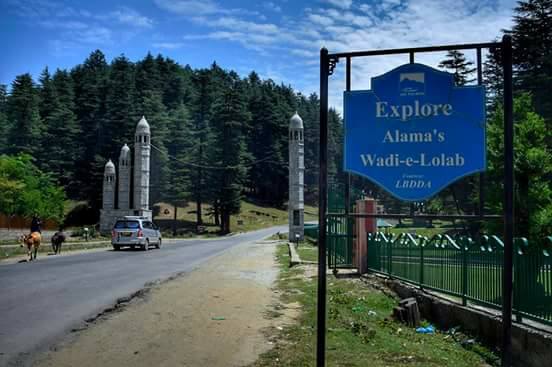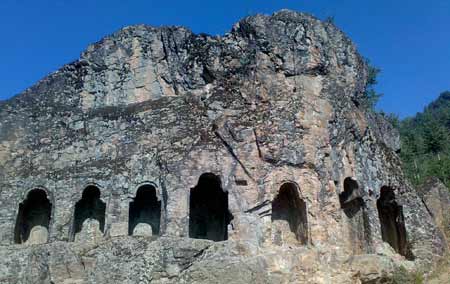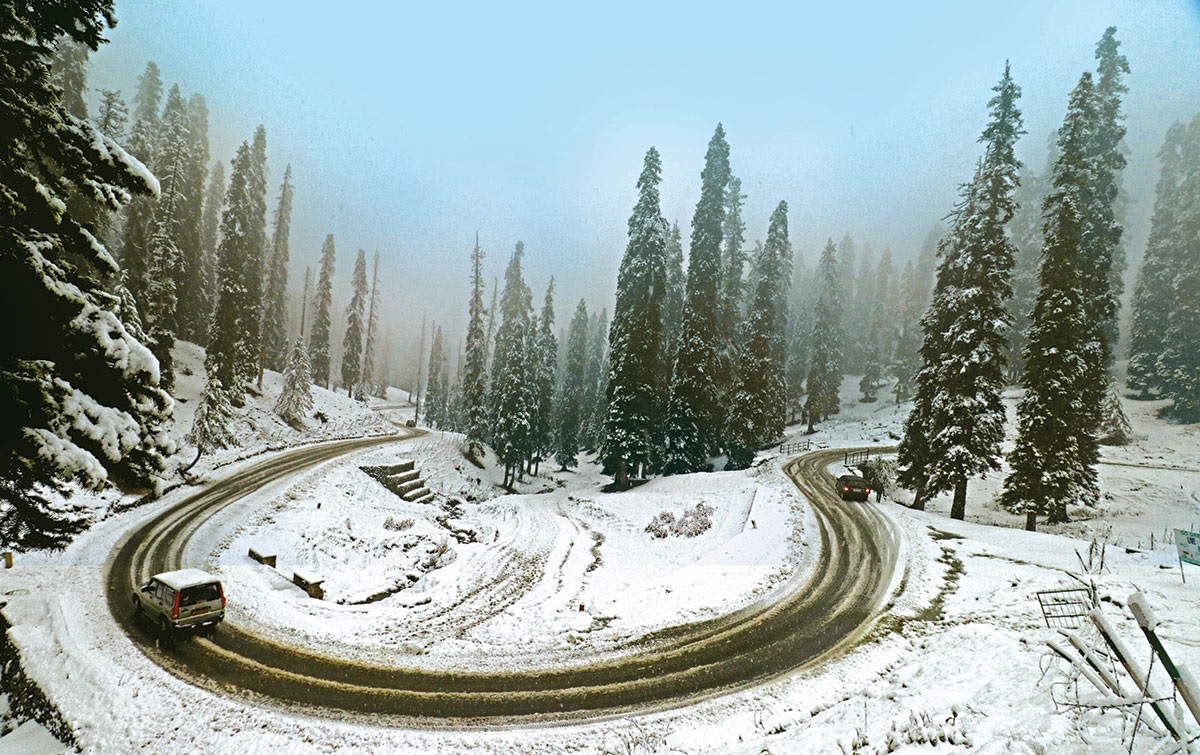Lolab’s beauty attracted poets and filmmakers in the past. Now things have changed but its lush pastures, woods, its myths and spirit of its people remain. Shafath Hussain revisits the place.

In our class 5th in a village school, general knowledge was the only subject which would evince interest among us. In one such incident, our teacher asked us to “give the full form of the abbreviation LOLAB”. I was the first, perhaps the only, student in the class to answer it: Land of love and beauty. I had enough ‘logic’ to support my answer. The biggest being Allama Iqbal ’s verses praising Lolab’s magnificent mountains and sweet, gushing waters; Paani tere cheshmu ka tadapta seem aab, Aae waad-e-lolab aae waad-e-Lolab.
While the teacher praised me and my classmates were clapping, a student sitting next to me, who did not belong to Lolab whispered in my ears (to avoid the wrath of the teacher who felt proud of being a Lolabi) that LOLAB stood more for the ‘land of loins and bears’ – wild animals. His words were embarrassing. I felt like complaining to the teacher. However, the troops posted outside subjecting me and my father to frisking and some unusual questioning was haunting me. That continues to haunt me even today. His answer, I felt then, was more appropriate than mine at that time.
 Things had changed. Lolab valley, where a part of Bollywood movie Sarhad ke Us Paar was shot, was now frequently in news for altogether different reasons. Poet’s stopping praised its beauty as it became a dreaded place to live. Encounters, killings, disappearances, arrests, tortures were all that there to talk about. Ironically Lolab again found bollywood’s attention. This time in movie Zameen as a militant haven.
Things had changed. Lolab valley, where a part of Bollywood movie Sarhad ke Us Paar was shot, was now frequently in news for altogether different reasons. Poet’s stopping praised its beauty as it became a dreaded place to live. Encounters, killings, disappearances, arrests, tortures were all that there to talk about. Ironically Lolab again found bollywood’s attention. This time in movie Zameen as a militant haven.
I left. After many years I returned. Curious to know if anything had improved from the horrible times when candles and lanterns were put off before eight in the evening (electricity was a rare commodity then and it still is). The natural beauty of the area, somewhat, camouflages the dreaded episodes of yesteryears.
When one reaches the Lolab valley, which once was like a paradise, two things strike you. One, the huge concentration of the troops – garrisons, barracks and soldiers scattered everywhere. The other is the vast graveyards giving peace to both known and unnamed souls.
I wanted to explore something beyond the beauty and the brutalities of Lolab. Something inane. Something trivial. Just 10 kilometres from the district headquarters, Kupwara, There is a village – Kalaroos.

Kalaroos is a big village on Kupwara-Machhil road. Owing to its central location in the area it hosts a New Type Primary Health Centre, a police station, a bank, a higher secondary and, not to forget, a garrison.
Some things and myths associated with Kalaroos make it famous. A popular myth says that a cave near the village is a way to Russia. Then there is Satbaran – in real life.
Adjoining Kalaroos is a small village called Lashtiyal. After the village houses end a narrow, steep, uphill footpath leads to the monumental rock called Satbaran. In Kashmiri, it means “with seven doors”. This massive rock is a historical marvel. The rock is half buried. The front side has got seven prominent engraved doors each of it being more than three feet deep.
Mahad Lone (71) a local resident says that he has seen it all his life. “It was very famous, even Angrez (foreigners usually white Britons) used to visit,” he adds. Abdul Aziz a local school teacher believes that it is perhaps as old as ancient temples of Pattan and might have been built by the Pandavs. Pandavs have built many structures in many villages of Kupwara too but they have remained unnoticed.
All the doors of the rock open on the front side, with the central door slightly bigger than the rest. It has a small hole on one side. “The shape and the structure look as if it had been a temple with their biggest god in the middle. A small hole might have been a separate entry for the sacred snake as there are in temples outside Kashmir,” says local resident Haji Amanullah.
There were two shelves each on every door which might have been used to put a Mashaal (torch) near the gate. Satbaran has a second rock next to it which also has a door carved on it. But neither so deep nor so well engraved. A cursory look will make any curious person to relate it to the Pattan temples. One wonders if those who made it were in a hurry or had left it unfinished.
The apathy of the authorities has paved its way to erosion. It has worn in many places. The children and young men have broken the sides and written their names along with the names of their beloved on it. Thanks to the local population who somehow have preserved it even when authorities neglected. Locals believe that Satbaran, centuries ago might have been a temple, where Pandavs or others might have been worshipping before heading towards the cave which popular myth says is a tunnel.
The cave opening is approximately 200 meters upwards Satbaran. A steep slope leads to it. Zahoor Wani, a local resident who works in the government accompanied me to the cave. A couple of feet away, from the ‘tunnel’ one big and two small snakes were loitering around. The snakes on sensing our presence disappeared in the nearby bushes.
A young boy who had come there to collect firewood, said, “We always come (to this place) with an axe or any other metallic tool”.
Many people have made a foray into the cave.
 “Before the 65 war (Indo-Pak war of 1965), as a child, I and my cousin, who was cocksure that the Russians might come one day through the tunnel, went inside the cave. We went inside before noon and travelled in the light of a kerosene lantern. We travelled a lot before we heard a huge sound of running water. We were afraid and returned, only to find that it was already evening,” says Mahad lone an elderly villager.
“Before the 65 war (Indo-Pak war of 1965), as a child, I and my cousin, who was cocksure that the Russians might come one day through the tunnel, went inside the cave. We went inside before noon and travelled in the light of a kerosene lantern. We travelled a lot before we heard a huge sound of running water. We were afraid and returned, only to find that it was already evening,” says Mahad lone an elderly villager.
Nusrat, a school teacher, says that some years back she has travelled around three hundred meters inside the cave. “We were a group of teachers and went inside. The entrance is narrow and only one person can go in at a time. There is a very big lobby inside with many ways”.
Nusrat says that there were animal carcasses in the cave making her believe that big cats used it to eat their prey.
Wani says that at some places the cave is so narrow that one has to crawl and somewhere it is as wide as a two-lane road. Just a few meters down the tunnel it is very dark and one can do nothing without some light.
Aziz Lone, an octogenarian says that once some Britons went inside the cave, they went a long way but found the tunnel unending. Ghulam Hassan, one of the oldest living persons of the village, says that they were scared of the cave. “During our childhood, we heard many mystical and atrocious stories of it,” Hassan said. However, some locals have ventured inside the cave. Young Zubair says that there is a large lobby inside besides many ladders which at some places go up and somewhere down. “This might have been built by the best engineer,” says Zubair.
The last time Kalaroos, locals say, received some government attention was when the department of geology and mining was exploring copper mines in the area.
Hassan Lone was employed by the department for ten years. “They worked almost for two decades and abandoned the work much before the militancy. We used only to drill deep in the ground with machines, collect samples, pack it and send for testing to Hindustan. The department later said that the copper found here was of low quality.” Many young people, however, think that the tunnel or cave might have been dug by miners to extract copper.
Whatever the mystery of the Kalaroos cave (or tunnel) or Satbaran, it exudes an awe among the locals who think that it leads to somewhere if not Rous (Russia) as nobody has yet reached the end of the ‘tunnel’.
















i also enter these caves.. i found 7 caves inside the main cave..it was very very rare and beautiful moments for me..(kalaroos caves)
i love to visits these places..